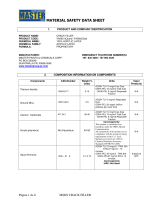mouth, mucous membranes).
Effects Of Overexposure - Ingestion: Harmful if swallowed. Ingestion may cause irritation to mucous
membranes. Ingestion may result in obstruction when material hardens.
Effects Of Overexposure - Chronic Hazards: The International Agency for Research on Cancer (IARC)
has determined that crystalline silica in the form of quartz or cristobalite that is inhaled from occupational
sources is carcinogenic to humans (Group 1- carcinogenic to humans). Refer to IARC Monograph 68,
Silica, Some Silicates and Organic Fibres (published in June 1997) in conjunction with the use of these
materials. The National Toxicology Program (NTP) classifies respirable crystalline silica as "known to be a
human carcinogen". Refer to the 9th Report on Carcinogens (2000). The American Conference of
Governmental Industrial Hygienists (ACGIH) classifies crystalline silica, quartz, as a suspected human
carcinogen (Group A2).
Breathing dust containing respirable crystalline silica may not cause noticeable injury or illness even
though permanent lung damage may be occurring. Inhalation of dust may have the following serious
chronic health effects: Excessive inhalation of respirable dust can cause pneumoconiosis, a respiratory
disease, which can result in delayed, progressive, disabling and sometimes fatal lung injury. Symptoms
include cough, shortness of breath, wheezing, non-specific chest illness and reduced pulmonary function.
Smoking exacerbates this disease. Individuals with pneumoconiosis are predisposed to develop
tuberculosis. There is some evidence that
breathing respirable crystalline silica or the disease silicosis is associated with an increased incidence of
significant disease endpoints such as scleroderma (an immune system disorder manifested by fibrosis of
the lungs, skin and other internal organs) and kidney disease. Inhalation of dust may result in pulmonary
and respiratory damages.
Primary Route(s) Of Entry: Skin Contact, Inhalation, Eye Contact
Medical Conditions which May be Aggravated by Exposure: Asthma and asthma-like conditions may
worsen from prolonged and repeated exposure.
Section 4 - First Aid Measures
First Aid - Eye Contact: In case of contact, immediately flush eyes with large quantities of water for at
least 15 minutes until irritation subsides. Get medical attention immediately.
First Aid - Skin Contact: Wash skin with soap and water for 15 minutes. Get medical aid if symptoms
persist.
First Aid - Inhalation: If inhaled, remove to fresh air. If not breathing, give artificial respiration. If
breathing is difficult, give oxygen. Get medical attention immediately.
First Aid - Ingestion: If swallowed, DO NOT INDUCE VOMITING. Get medical attention immediately.
Note to Physician: None.









